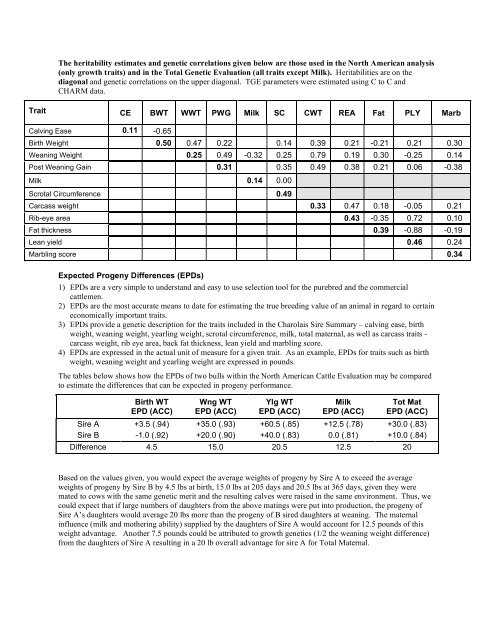Interpreting the Sire Summary - CCA Breed Improvement
Interpreting the Sire Summary - CCA Breed Improvement
Interpreting the Sire Summary - CCA Breed Improvement
Create successful ePaper yourself
Turn your PDF publications into a flip-book with our unique Google optimized e-Paper software.
The heritability estimates and genetic correlations given below are those used in <strong>the</strong> North American analysis<br />
(only growth traits) and in <strong>the</strong> Total Genetic Evaluation (all traits except Milk). Heritabilities are on <strong>the</strong><br />
diagonal and genetic correlations on <strong>the</strong> upper diagonal. TGE parameters were estimated using C to C and<br />
CHARM data.<br />
Trait CE BWT WWT PWG Milk SC CWT REA Fat PLY Marb<br />
Calving Ease 0.11 -0.65<br />
Birth Weight 0.50 0.47 0.22 0.14 0.39 0.21 -0.21 0.21 0.30<br />
Weaning Weight 0.25 0.49 -0.32 0.25 0.79 0.19 0.30 -0.25 0.14<br />
Post Weaning Gain 0.31 0.35 0.49 0.38 0.21 0.06 -0.38<br />
Milk 0.14 0.00<br />
Scrotal Circumference 0.49<br />
Carcass weight 0.33 0.47 0.18 -0.05 0.21<br />
Rib-eye area 0.43 -0.35 0.72 0.10<br />
Fat thickness 0.39 -0.88 -0.19<br />
Lean yield 0.46 0.24<br />
Marbling score 0.34<br />
Expected Progeny Differences (EPDs)<br />
1) EPDs are a very simple to understand and easy to use selection tool for <strong>the</strong> purebred and <strong>the</strong> commercial<br />
cattlemen.<br />
2) EPDs are <strong>the</strong> most accurate means to date for estimating <strong>the</strong> true breeding value of an animal in regard to certain<br />
economically important traits.<br />
3) EPDs provide a genetic description for <strong>the</strong> traits included in <strong>the</strong> Charolais <strong>Sire</strong> <strong>Summary</strong> – calving ease, birth<br />
weight, weaning weight, yearling weight, scrotal circumference, milk, total maternal, as well as carcass traits -<br />
carcass weight, rib eye area, back fat thickness, lean yield and marbling score.<br />
4) EPDs are expressed in <strong>the</strong> actual unit of measure for a given trait. As an example, EPDs for traits such as birth<br />
weight, weaning weight and yearling weight are expressed in pounds.<br />
The tables below shows how <strong>the</strong> EPDs of two bulls within <strong>the</strong> North American Cattle Evaluation may be compared<br />
to estimate <strong>the</strong> differences that can be expected in progeny performance.<br />
Birth WT<br />
EPD (ACC)<br />
Wng WT<br />
EPD (ACC)<br />
Ylg WT<br />
EPD (ACC)<br />
Milk<br />
EPD (ACC)<br />
Tot Mat<br />
EPD (ACC)<br />
<strong>Sire</strong> A +3.5 (.94) +35.0 (.93) +60.5 (.85) +12.5 (.78) +30.0 (.83)<br />
<strong>Sire</strong> B -1.0 (.92) +20.0 (.90) +40.0 (.83) 0.0 (.81) +10.0 (.84)<br />
Difference 4.5 15.0 20.5 12.5 20<br />
Based on <strong>the</strong> values given, you would expect <strong>the</strong> average weights of progeny by <strong>Sire</strong> A to exceed <strong>the</strong> average<br />
weights of progeny by <strong>Sire</strong> B by 4.5 lbs at birth, 15.0 lbs at 205 days and 20.5 lbs at 365 days, given <strong>the</strong>y were<br />
mated to cows with <strong>the</strong> same genetic merit and <strong>the</strong> resulting calves were raised in <strong>the</strong> same environment. Thus, we<br />
could expect that if large numbers of daughters from <strong>the</strong> above matings were put into production, <strong>the</strong> progeny of<br />
<strong>Sire</strong> A’s daughters would average 20 lbs more than <strong>the</strong> progeny of B sired daughters at weaning. The maternal<br />
influence (milk and mo<strong>the</strong>ring ability) supplied by <strong>the</strong> daughters of <strong>Sire</strong> A would account for 12.5 pounds of this<br />
weight advantage. Ano<strong>the</strong>r 7.5 pounds could be attributed to growth genetics (1/2 <strong>the</strong> weaning weight difference)<br />
from <strong>the</strong> daughters of <strong>Sire</strong> A resulting in a 20 lb overall advantage for sire A for Total Maternal.


